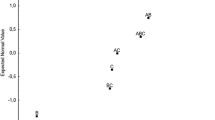Abstract
Operation of an industrial installation for cyclohexane oxidation was analyzed, and causes of the low process selectivity (45–52%) were elucidated. The relationships of cyclohexane oxidation under laboratory conditions maximum similar to those of the industrial process were studied. Measures were suggested for optimizing the process so as to increase the yield of the target products by a factor of 1.2–1.6, decrease the amount of cyclohexane spent for the formation of by-products by a factor of 1.2–1.8, and increase the process selectivity to 68%.
Similar content being viewed by others
References
State of the Art of Production and Market of Caprolactam and Polyamide in CIS Countries, Evraz. Khim. Rynok, 2010, no. 13(73), pp. 64–72.
Potekhin, V.M. and Potekhni, V.V., Osnovy teorii khimichesikh protsessov tekhnologii organicheskikh veshchestv i neftepererabotki (Principles of the Theory of Chemical Processes in Production of Organic Substances and Oil Refi ning), St. Petersburg: Lan’, 2014.
Pohorecki, R., Badyga, J., Moniuk, W., et al., Chem. Eng. Sci., 2001, vol. 56, pp. 1285–1291.
Glazko, I.L., Levanova, S.V., Martynenko, E.A., and Sokolova, A.A., Russ. J. Appl. Chem., 2011, vol. 84, no. 10, pp. 1767–1771.
Musser, M.T., Cyclohexanol and Cyclohexanone: Ullmann’s Encyclopedia of Industrial Chemistry, Weinheim: Wiley–VCH, 2000.
Hexin Hu, San Bin, and Wang Enquan, Petrol. Process. Petrochem., 2011, vol. 42, no. 6, pp. 84–87.
Martynenko, E.A., Glazko, I.L., Levanova, S.V., and Portnova, Yu.V., Russ. J. Appl. Chem., 2014, vol. 87, no. 7, pp. 899–903.
Martynenko, E.A., Glazko, I.L., Levanova, S.V., and Portnova, Yu.V., Petrol. Chem., 2015, no. 3, pp. 229–234.
Ovchinnikov, V.I. and Ruchinskii, V.P., Proizvodstvo kaprolaktama (Caprolactam Production), Moscow: Khimiya, 1977. p. 264.
Serinyel, Z., Herbinet, O., Frottier, O., et al., Combust. Flame, 2013, vol. 160, pp. 2319–2332.
Author information
Authors and Affiliations
Corresponding author
Additional information
Original Russian Text © I.L. Glazko, Yu.V. Portnova, S.V. Sushkova, S.V. Levanova, A.B. Sokolov, 2015, published in Zhurnal Prikladnoi Khimii, 2015, Vol. 88, No. 12, pp. 1716–1721.
Rights and permissions
About this article
Cite this article
Glazko, I.L., Portnova, Y.V., Sushkova, S.V. et al. Ways of controlling the selectivity of cyclohexane oxidation. Russ J Appl Chem 88, 1963–1968 (2015). https://doi.org/10.1134/S10704272150120101
Received:
Published:
Issue Date:
DOI: https://doi.org/10.1134/S10704272150120101



